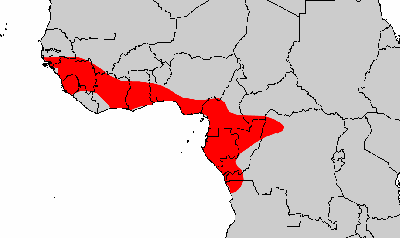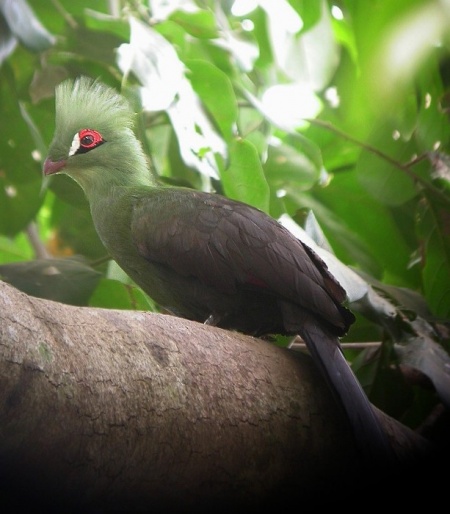Alternative names: Green Turaco; Green-crested Turaco; Green Lourie; Turacus persa
- Tauraco persa
Identification
40–43 cm (15¾-17 in) Typical "green", round-crested Turaco.
Forehead and crown green with a yellow component, small red tips to the crown/crest. Nape and upper back lack yellow component. Lower back, rump and upper tail coverts very dark green. lores yellowish green with vertical white line in front of the eye and a very thin black line along the lower edge. Thin black eye-stripe behind the eye, a thin white stripe running from under the eye to the upper rear corner of the ear-coverts; ear coverts and sides to the neck bright green. Chin, throat, upper breast and fore flanks bright green. Rest of underparts dark green.
Wing coverts bronzy-purple, primaries and secondaries bright rufous with black tips.
Tail blackish-green with a purplish gloss.
Bill red with a small black tip, eyering bright red, eye dark, legs and feet black.
Sexes similar. Immatures are similar but have more extensive black tipping to primaries.
Variations
Western taxon buffoni has a broader black eyestripe and reduced, or absent white stripe underneath the eye.
Distribution
 Graphic by Nrg800 |
West Africa: From Gambia and Senegal in the west to Central African Republic, Republic of Congo, Democratic Republic of Congo, and Angola. Fairly common and widespread over much of its range. |
Taxonomy
Subspecies
Tauraco persa has three subspecies[1]:
- T. p. persa from Ivory Coast to Ghana and Cameroon
- T. p. buffoni from Senegal and the Gambia to Liberia
- T. p. zenkeri from southern Cameroon to Gabon, northern Angola, Congo and northwest DRC
Habitat
Found in lowland and gallery forest. Often along edges of cultivation and along rivers.
Occurs from sea-level up to 1100m, occasionally higher.
Behaviour
Diet
Feeds mainly on fruits, takes also flowers and buds.
Breeding
Breeding season differs through range. The nest is a platform made of sticks and twigs. It's placed in the thickest part of an isolated bush or tree, 1.5 to 5.3 m above the ground. Lays generally 2 eggs.
Vocalisation
Barking "kow kow kow kow", sounds like a yapping dog at any distance. Regular in spacing. ====Movements A sedentary species. Some birds occasionally wander to riverine and gallery forests in search of food.
References
- Clements, J. F., T. S. Schulenberg, M. J. Iliff, D. Roberson, T. A. Fredericks, B. L. Sullivan, and C. L. Wood. 2015. The eBird/Clements checklist of birds of the world: v2015, with updates to August 2015. Downloaded from http://www.birds.cornell.edu/clementschecklist/download/
- Del Hoyo, J, A Elliot, and J Sargatal, eds. 1997. Handbook of the Birds of the World. Volume 4: Sandgrouse to Cuckoos. Barcelona: Lynx Edicions. ISBN 978-8487334221
- Lepage D. 2008. Avibase. Search for "Guinea Turaco" downloaded 19 April 2008.
- Sinclair I, Ryan P. 2003. Birds of Africa south of the Sahara. Princeton University Press. ISBN 0 620 20729 9
Recommended Citation
- BirdForum Opus contributors. (2025) Guinea Turaco. In: BirdForum, the forum for wild birds and birding. Retrieved 9 May 2025 from https://www.birdforum.net/opus/Guinea_Turaco




